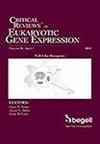SIAH1 promotes the pyroptosis of cardiomyocytes in diabetic cardiomyopathy via regulating IκB-α/NF-κB signaling
IF 1.5
4区 医学
Q4 BIOTECHNOLOGY & APPLIED MICROBIOLOGY
Critical Reviews in Eukaryotic Gene Expression
Pub Date : 2024-02-01
DOI:10.1615/critreveukaryotgeneexpr.2024052773
引用次数: 0
Abstract
Inflammation-mediated dysfunction of cardiomyocytes is the main cause of diabetic cardiomyopathy (DCM). The present study aimed to investigate the roles of SIAH1 in DCM. RT-qPCR was conducted to detect mRNA levels. ELISA was performed to detect cytokine release. Western blot was used to detect protein expression. LDH assay was used to determine cytotoxicity. In vitro ubiquitination assay was applied to determine the ubiquitination of IκB-α. TUNEL assay was conducted to determine cell death. Flow cytometry was applied for determining cardiomyocyte pyroptosis. The results showed that SIAH1 was overexpressed in human inflammatory cardiomyopathy. High expression of SIAH1 was associated with inflammatory response. SIAH1 was also overexpressed lipopolysaccharide (LPS)-induced inflammatory cardiomyopathy model in vitro. However, SIAH1 knockdown suppressed the inflammatory-related pyroptosis of cardiomyocytes. SIAH1 promoted the ubiquitination of IκB-α and activation of NF-κB signaling, which promoted the pyroptosis of cardiomyocytes. In conclusion, SIAH1 exacerbated the progression of human inflammatory cardiomyopathy via inducing the ubiquitination of IκB-α and activation of NF-κB signaling. Therefore, SIAH1/IκB-α/NF-κB signaling may be a potential target for human inflammatory cardiomyopathy.SIAH1 通过调控 IκB-α/NF-κB 信号促进糖尿病心肌病中心肌细胞的脓毒症
炎症介导的心肌细胞功能障碍是糖尿病心肌病(DCM)的主要病因。本研究旨在探讨 SIAH1 在 DCM 中的作用。采用 RT-qPCR 检测 mRNA 水平。ELISA 检测细胞因子的释放。Western blot用于检测蛋白质表达。LDH 检测用于确定细胞毒性。体外泛素化试验用于检测 IκB-α 的泛素化情况。采用 TUNEL 检测法确定细胞死亡。流式细胞术用于确定心肌细胞的热解。结果显示,SIAH1在人类炎症性心肌病中过度表达。SIAH1 的高表达与炎症反应有关。在脂多糖(LPS)诱导的体外炎症性心肌病模型中,SIAH1也存在过表达。然而,SIAH1的敲除抑制了心肌细胞与炎症相关的热休克。SIAH1促进了IκB-α的泛素化和NF-κB信号的激活,从而促进了心肌细胞的热解。总之,SIAH1通过诱导IκB-α泛素化和激活NF-κB信号,加剧了人类炎症性心肌病的进展。因此,SIAH1/IκB-α/NF-κB 信号转导可能是人类炎症性心肌病的潜在靶点。
本文章由计算机程序翻译,如有差异,请以英文原文为准。
求助全文
约1分钟内获得全文
求助全文
来源期刊

Critical Reviews in Eukaryotic Gene Expression
生物-生物工程与应用微生物
CiteScore
2.70
自引率
0.00%
发文量
67
审稿时长
1 months
期刊介绍:
Critical ReviewsTM in Eukaryotic Gene Expression presents timely concepts and experimental approaches that are contributing to rapid advances in our mechanistic understanding of gene regulation, organization, and structure within the contexts of biological control and the diagnosis/treatment of disease. The journal provides in-depth critical reviews, on well-defined topics of immediate interest, written by recognized specialists in the field. Extensive literature citations provide a comprehensive information resource.
Reviews are developed from an historical perspective and suggest directions that can be anticipated. Strengths as well as limitations of methodologies and experimental strategies are considered.
 求助内容:
求助内容: 应助结果提醒方式:
应助结果提醒方式:


